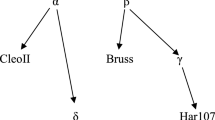Abstract
Many catalogues of animals and sounds exist in medieval glossaries, poems, or other types of text. Most descend from a list associated with Polemius Silvius, one associated with Phocas, one associated with Aldhelm, or one associated with the poem De Philomela. Some are mixtures, editions even, of lists from multiple sources. One such text in Cambridge University Library shows a 'scientist' using scientific methods to classify and organize linguistic material.
Similar content being viewed by others
References
Benediktson, D. T. “Polemius Silvius' 'Voces Varie Animancium' and Related Catalogues of Animal Sounds.” Mnemosyne 53 (2000): 71–77.
Berndt, Günter. Carmina Burana.Die Lieder der Benediktbeurer Handschrift.Zweisprachige Ausgabe. Munich: Deutscher Taschenbuch Verlag, 1979.
Boas, M. The Scientific Renaissance: 1450–1630. New York: Harper and Row, 1962.
Crombie, A. C. Medieval and Early Modern Science. 2nd edition. 2 volumes. Cambridge, Mass., and London: Harvard University Press and William Heinemann, Ltd., 1961.
Diaz y Diaz, M. C. “Sobre las series de voces de animales,” Latin Script and Letters A.D.400–900: Festschrift presented to Ludwig Bieler on the occasion of his 70th birthday. Eds. J. J. O'Meara and B. Naumann. Leiden: Brill, 1976, pp. 148–155.
Ehwald, R. Aldhelmi Opera.Monumenta Germaniae Historica 15. Berlin: Weidmann, 1919, repr. Münich: Monumenta Germaniae Historica, 1984.
Finch, C. E. “Suetonius' Catalogue of Animal Sounds in Codex Vat. Lat. 6018.” American Journal of Philology 90:4 (1969): 459–463.
Flores, N. C. “The Mirror of Nature Distorted: The Medieval Artist's Dilemma in Depicting Animals.” The Medieval World of Nature: A Book of Essays. Ed. J. E. Salisbury. New York and London: Garland, 1993, pp. 3–45.
Goetz, G., and G. Loewe. Corpus Glossariorum Latinorum. 6 volumes. Leipzig and Berlin: Teubner, 1888–1923, repr. Amsterdam: Hakkert, 1965.
Grant, E. Physical Science in the Middle Ages. Cambridge, London, New York and Melbourne: Cambridge University Press, 1977.
Haskins, C. H. Studies in the History of Mediaeval Science. 2nd edition. Cambridge, Mass.: Harvard University Press, 1927.
lriarte, J. Regiae Bibliothecae Codices Graeci MSS. 2 volumes. Madrid: de Soto, 1769.
Klenner, K.-E. Der Tierstimmen-Katalog als literarisches Phänomen (Diss.: Münster, Münster and Westfalen: Kramer, 1958).
Klopsch, P. “Carmen de Philomela,” Literatur und Sprache im europäischen Mittelalter.Festschrift für Karl Langosch zum 70.Geburtstag. Eds. A. Önnerfors et al. Darmstadt: Wissenschaftliche Buchgesellschaft, 1973, pp. 173–194.
Lagorio, V. M. “Three More Vatican Manuscripts of Suetonius's Catalogue of Animal Sounds.” Scriptorium 35 (1981): 59–62.
Lewis, C. T., and C. Short. A Latin Dictionary. Oxford: Oxford University Press, 1879.
Lindsay, W. M. “Bird-names in Latin Glossaries.” Classical Philology 13:1 (1918): 1–13.
Loewe, G. Prodromos Corporis Glossariorum Latinorum. Leipzig: Teubner, 1876.
Loewe, G. Glossae Nominum. Leipzig: Teubner, 1884.
Loewe, G. “Suetoniana.” Rheinisches Museum 34 (1879): 493–496.
Mai, A. Classicorum Auctorum e Vaticanis Codicibus Editorum. 10 volumes. Rome: Vatican, 1828–1838.
Marcovich, M. “Voces Animantium and Suetonius.” Živa Antika 21 (1971): 399–416.
Migne, J.-P. Patrilogiae Cursus Completus Series Latina. 221 volumes. Paris: Migne, 1844–1857, reprinted on microfiche Leiden: IDC, 1988.
Oggins, R. S. “Falconry and Medieval Views of Nature,” The Medieval World of Nature: A Book of Essays. Ed. J. E. Salisbury. New York and London: Garland, 1993, pp. 47–60.
Reifferscheid, A. C.Suetonius Tranquillus praeter Caesarum Libros Reliquiae. Leipzig: Teubner, 1860, reprinted Hildesheim and New York: Olms, 1971.
Singer, C. A History of Biology: A General Introduction to the Study of Living Things. Revised edition. New York: Schuman, 1950.
Stahl, W. H. Roman Science: Origins, Development, and Influence to the Later Middle Ages. Madison: University of Wisconsin Press, 1962.
Stannard, J. “Natural History,” Science in the Middle Ages. Ed. D. C. Lindberg. Chicago and London: University of Chicago Press, 1978, pp. 429–460.
Thompson, D. W. “Notes on the Foregoing Article.” Classical Philology 13:1 (1918): 13–22.
Wackernagel, W. Voces Variae Animantium. Second edition. Basel: Bahnmeier, 1869.
Winterfeld, P. de. Poetae Latini Aevi Carolini. 4 volumes. Berlin: Weidmann, 1899.
Author information
Authors and Affiliations
Rights and permissions
About this article
Cite this article
Benediktson, D.T. Cambridge University Library L1 1 14, F. 46r–v: A Late Medieval Natural Scientist at Work. Neophilologus 86, 171–177 (2002). https://doi.org/10.1023/A:1014422702245
Issue Date:
DOI: https://doi.org/10.1023/A:1014422702245




